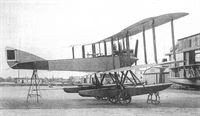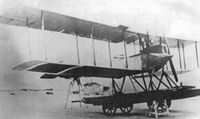
Описание
Страна: Германия
Год: 1917
Варианты
- Avro - 501 - 1913 - Великобритания
- Avro - 503/Type H - 1913 - Великобритания
- Gotha - WD.1/WD.2 - 1914 - Германия
- Gotha - WD.5/WD.9 - 1915 - Германия
- Gotha - WD.12/WD.13/WD.15 - 1917 - Германия
- O.Thetford, P.Gray German Aircraft of the First World War (Putnam)
- J.Herris Gotha Aircraft of WWI (A Centennial Perspective on Great War Airplanes 6)
- M.Dusing German Aviation Industry in WWI. Volume 1 (A Centennial Perspective on Great War Airplanes 84)
-
M.Dusing - German Aviation Industry in WWI. Volume 2 /Centennial Perspective/ (85)
This Gotha WD.12a, Marine No.944 was equipped with Daimler D.III engine and Reschke propeller.
-
C.Owers - Hansa-Brandenburg Aircraft of WWI. Volume 1 - Landplanes /Centennial Perspective/ (17)
A typical Norderney winter scene with a Brandenburg FB hiding at the waterline with Gotha WD7 MN 674 at left and Brandenburg NW (Gotha WD12 ???) floatplanes
Другие самолёты на фотографии: Gotha WD.7 - Германия - 1916Hansa-Brandenburg FB - Германия - 1915
-
J.Herris - Gotha Aircraft of WWI /Centennial Perspective/ (6)
The prototype WD12 showing the observer's faired headrest, consistent with this aircraft being unarmed.
-
J.Herris - Gotha Aircraft of WWI /Centennial Perspective/ (6)
One of the Turkish WD12 seaplanes showing the aft gunner's cockpit with gun ring. This distinguishes the Turkish WD12s from the unarmed prototype used by the German Navy.
The Turkish Navy operated a number of Gotha WD12 seaplanes; its duration of over five hours made it useful for patrols over the Black Sea. -
J.Herris - Gotha Aircraft of WWI /Centennial Perspective/ (6)
Side view of a WD13 in Turkish markings on a beaching dolly.The observer's gun ring is clearly visible. Unlike most preceding Gotha seaplanes, the rudder has no aerodynamic balance. The German Navy evaluated the WD13 but did not purchase any; all six WD13s built were purchased and operated by Turkey.
-
J.Herris - Gotha Aircraft of WWI /Centennial Perspective/ (6)
Little more than a cleaned up, 160hp Benz Bz IIIa-engined Gotha WD 9, their two seat WD 13 coastal patroller was bought by the navy in 1917 specifically for Turkish use. Built only in small numbers, the WD 13's top level speed was 87mph, the machine had a useful operational range of 466 miles. The observer's gun ring is clearly visible.
-
J.Herris - Gotha Aircraft of WWI /Centennial Perspective/ (6)
Gotha WD13 in Turkish markings. The German Navy evaluated the WD13 but did not purchase any; all WD13s were purchased and operated by Turkey.
-
M.Dusing - German Aviation Industry in WWI. Volume 1 /Centennial Perspective/ (84)
Gotha WD9 (WD13 ???) (1916)
-
J.Herris - Gotha Aircraft of WWI /Centennial Perspective/ (6)
The first prototype WD15, Marine Number 842, before the Marine Number was added. The first prototype had ailerons on the upper wings only.
-
J.Herris - Gotha Aircraft of WWI /Centennial Perspective/ (6)
The first prototype WD15, Marine Number 842, on beaching dollies.
-
J.Herris - Gotha Aircraft of WWI /Centennial Perspective/ (6)
The first prototype WD 15, Marine Number 842, on beaching dollies. The typical Gotha rudder with horn balance underneath is evident.
-
J.Herris - Gotha Aircraft of WWI /Centennial Perspective/ (6)
The first prototype WD15, Marine Number 842, on a beaching dolly upon delivery to the SVK.
-
J.Herris - Gotha Aircraft of WWI /Centennial Perspective/ (6)
The first prototype WD15, Marine Number 842, in the Gotha factory pond before the Marine Number was added.
-
J.Herris - Gotha Aircraft of WWI /Centennial Perspective/ (6)
The first prototype WD 15, Marine Number 842, on dollies.The 260 hp Mercedes D.IVa engine gave the WD15 good performance but both prototypes suffered from engine problems despite the Mercedes D.IVa being a generally reliable engine in mass production and use. The Gotha bombers used the Mercedes D.IVa without significant problems, so the numerous problems with the D.IVa in the WD15 were unusual.
-
J.Herris - Gotha Aircraft of WWI /Centennial Perspective/ (6)
The second prototype WD15, Marine Number 843, afloat in the Gotha factory pond. The second prototype WD15 incorporated a number of improvements as a result of flight testing the first prototype; the most visible was the use of ailerons on all wings, with the upper and lower ailerons connected by an actuating strut. Like the first prototype, the second prototype also suffered a number of engine problems with its 260 hp Mercedes D.IVa engine, and despite being accepted in January 1918, the SVK did not approve series production.
O.Thetford, P.Gray German Aircraft of the First World War (Putnam)
Gotha WD 12
Only a single specimen (No. 944) of this unarmed patrol seaplane was supplied to the German Navy, although other aircraft of this type were built for Turkey. Turkish machines were railed to Herkulesbad in Hungary, erected and flown across Rumania to Lom-Polanka in Bulgaria, where they were again transported to Constantinople. Engine, 160 h.p. Mercedes DIII. Span, 150 m. (49 ft. 2 5/8 in.). Length, 10.0 m. (32 ft. 9 3/4 in.). Height 3.825 m. (12 ft. 6 1/2 in.). Area, 54 sq.m. (583 sq.ft.). Weights: Empty 1,000 kg. (2,200 lb.). Loaded, 1,550 kg. (3,410 lb.). Speed, 141 km.hr (88.125 m.p.h.). Climb, 1,000 m. (3,280 ft.) in 7.5 min. Duration, 5 1/2 hr. Armament, none.
Gotha WD 13
This patrol seaplane was a development of the WD 9. None were used by Germany, those that were built were supplied to the Turkish Government during 1917. Engine, 150 h.p. Benz Bz III. Span, 14.6 m. (47 ft. 10 7/8 in.). Length, 10.068 m. (33 ft. 0 1/2 in.). Height, 3.74 m. (12 ft. 3 1/4 in.). Area, 49 sq.m. (529 sq.ft.). Weights: Empty, 1,061 kg. (2,334 lb.). Loaded, 1.463 kg. (3,219 lb.). Speed, 131.5 km.hr. (82.25 m.p.h.). Climb, 1,000 m. (3,280 ft.) in 9 min. Duration, 3 hr. Armament, one manually operated Parabellum machine-gun in rear cockpit.
Gotha WD 15
Built towards the end of 1917, the WD 15 was little more than an enlarged WD 12 with ply-skinned fuselage and fin. It was the most powerful and also the last single-engined machine to be supplied by Gotha to the German Navy. Only two were built, Nos. 842 and 843. Engine, 260 h.p. Mercedes D IVa. Span, 17.2 m. (56 ft. 5 1/4 in.). Length, 11.2 m. (36 ft. 9 in.). Area, 64.5 sq.m. (697 sq.ft.). Weights: Empty, 1,545 kg. (3,399 lb.). Loaded, 2,300 kg. (5,060 lb.). Speed, 152 km.hr. (95 m.p.h.). Ceiling, 4,200 m. (13,780 ft.). Armament, none.
Описание:




















